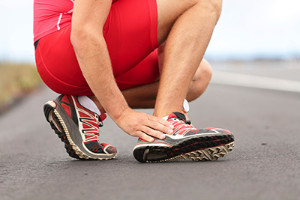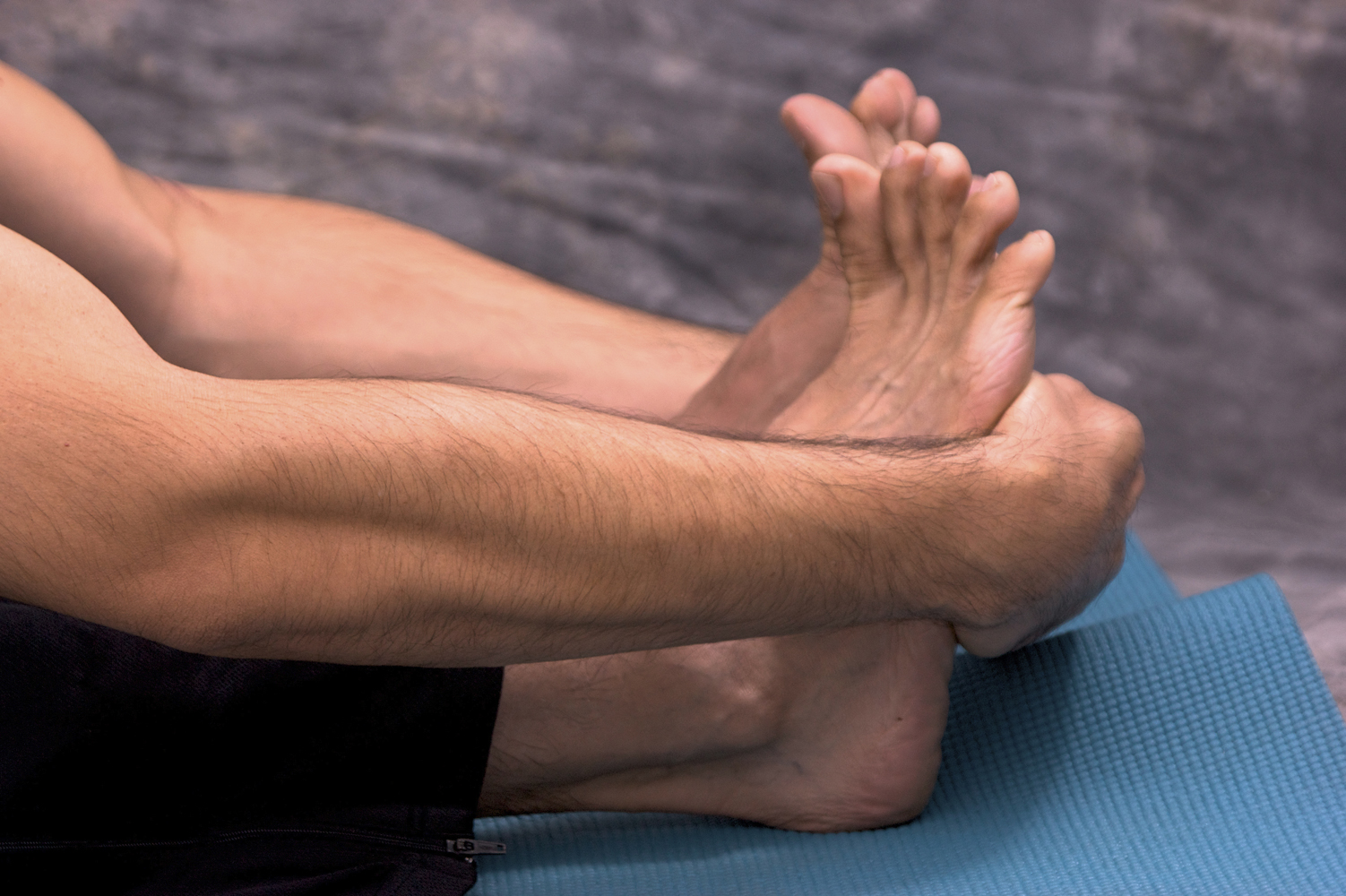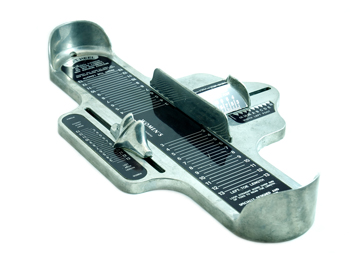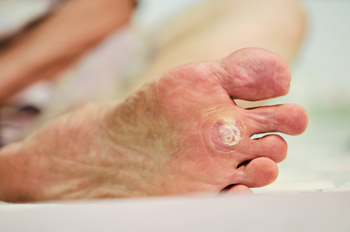Items filtered by date: March 2021
How Plantar Warts Spread
Plantar Warts, and warts in general, are caused by the Human Papilloma Virus (HPV). Plantar warts occur when the virus enters the skin through tiny cracks or weak spots in the skin on the soles of the feet and forms thick, flat warts—sometimes forming clusters. Plantar warts are painful and can make you feel like you are walking on pebbles. Although it is possible for plantar warts to go away on their own, they are hardy and may take years to disappear, if at all. If your plantar warts are causing you pain, discomfort, or embarrassment, contact a podiatrist. There are a variety of therapies and procedures they can use to get rid of plantar warts, including topical treatment, cryotherapy, and laser therapy. For a proper diagnosis please speak with a podiatrist.
Plantar warts can be very uncomfortable. If you need your feet checked, contact Donald Manger, DPM from Associated Podiatric Physicians, PA. Our doctor will assist you with all of your foot and ankle needs.
About Plantar Warts
Plantar warts are the result of HPV, or human papillomavirus, getting into open wounds on the feet. They are mostly found on the heels or balls of the feet.
While plantar warts are generally harmless, those experiencing excessive pain or those suffering from diabetes or a compromised immune system require immediate medical care. Plantar warts are easily diagnosed, usually through scraping off a bit of rough skin or by getting a biopsy.
Symptoms
- Lesions on the bottom of your feet, usually rough and grainy
- Hard or thick callused spots
- Wart seeds, which are small clotted blood vessels that look like little black spots
- Pain, discomfort, or tenderness of your feet when walking or standing
Treatment
- Freezing
- Electric tool removal
- Laser Treatment
- Topical Creams (prescription only)
- Over-the-counter medications
To help prevent developing plantar warts, avoid walking barefoot over abrasive surfaces that can cause cuts or wounds for HPV to get into. Avoiding direct contact with other warts, as well as not picking or rubbing existing warts, can help prevent the further spread of plantar warts. However, if you think you have developed plantar warts, speak to your podiatrist. He or she can diagnose the warts on your feet and recommend the appropriate treatment options.
If you have any questions please feel free to contact our office located in Hamilton Township, NJ . We offer the newest diagnostic and treatment technologies for all your foot and ankle needs.
Reminder: When Was the Last Time...?
Why Does my Heel Hurt?
 Heel pain can affect and hinder everyday life, and it can come from many different sources. The leading cause of heel pain is plantar fasciitis. This occurs when the plantar fascia, the band of tissue connecting the heels to the toes, becomes inflamed. Achilles tendonitis, which occurs when the Achilles tendon becomes inflamed, can also lead to heel pain. Other causes of heel pain can include arthritis, a stress fracture, bursitis, or the wearing down of the fat pad under the heel. Because of the variety of issues that can result in heel pain, patients who are suffering should seek the help of a podiatrist to find the source of their heel pain and relief.
Heel pain can affect and hinder everyday life, and it can come from many different sources. The leading cause of heel pain is plantar fasciitis. This occurs when the plantar fascia, the band of tissue connecting the heels to the toes, becomes inflamed. Achilles tendonitis, which occurs when the Achilles tendon becomes inflamed, can also lead to heel pain. Other causes of heel pain can include arthritis, a stress fracture, bursitis, or the wearing down of the fat pad under the heel. Because of the variety of issues that can result in heel pain, patients who are suffering should seek the help of a podiatrist to find the source of their heel pain and relief.
Many people suffer from bouts of heel pain. For more information, contact Donald Manger, DPM of Associated Podiatric Physicians, PA. Our doctor can provide the care you need to keep you pain-free and on your feet.
Causes of Heel Pain
Heel pain is often associated with plantar fasciitis. The plantar fascia is a band of tissues that extends along the bottom of the foot. A rip or tear in this ligament can cause inflammation of the tissue.
Achilles tendonitis is another cause of heel pain. Inflammation of the Achilles tendon will cause pain from fractures and muscle tearing. Lack of flexibility is also another symptom.
Heel spurs are another cause of pain. When the tissues of the plantar fascia undergo a great deal of stress, it can lead to ligament separation from the heel bone, causing heel spurs.
Why Might Heel Pain Occur?
- Wearing ill-fitting shoes
- Wearing non-supportive shoes
- Weight change
- Excessive running
Treatments
Heel pain should be treated as soon as possible for immediate results. Keeping your feet in a stress-free environment will help. If you suffer from Achilles tendonitis or plantar fasciitis, applying ice will reduce the swelling. Stretching before an exercise like running will help the muscles. Using all these tips will help make heel pain a condition of the past.
If you have any questions please contact our office located in Hamilton Township, NJ . We offer the newest diagnostic and treatment technologies for all your foot and ankle needs.
Causes and Symptoms of Cuboid Syndrome
 The cuboid bone is located on the outer side of your foot with a joint and ligaments nearby. These ligaments can tear or become otherwise damaged due to either an ankle sprain or other injury, or from the repetitive strain of certain sports and other activities. These conditions are known as cuboid syndrome, or cuboid subluxation. Cuboid syndrome can also develop in people with flat feet, or when a bone within the joint becomes slightly dislocated. Symptoms of cuboid syndrome usually present themselves on the lateral side of your foot where the ligaments are located, and can include swelling, tenderness, and redness. Additionally, you may experience diminishment in mobility of your ankle and even weakness in the toes nearest to the damaged ligament. While conditions such as arthritis and osteoporosis make you more prone to develop cuboid syndrome, you can reduce your risk by maintaining a healthy body weight, stretching before exercise, and wearing shoes that fit and offer adequate support. If you believe you are experiencing cuboid syndrome or have any pain in your foot, make an appointment with a podiatrist right away for proper diagnosis and treatment.
The cuboid bone is located on the outer side of your foot with a joint and ligaments nearby. These ligaments can tear or become otherwise damaged due to either an ankle sprain or other injury, or from the repetitive strain of certain sports and other activities. These conditions are known as cuboid syndrome, or cuboid subluxation. Cuboid syndrome can also develop in people with flat feet, or when a bone within the joint becomes slightly dislocated. Symptoms of cuboid syndrome usually present themselves on the lateral side of your foot where the ligaments are located, and can include swelling, tenderness, and redness. Additionally, you may experience diminishment in mobility of your ankle and even weakness in the toes nearest to the damaged ligament. While conditions such as arthritis and osteoporosis make you more prone to develop cuboid syndrome, you can reduce your risk by maintaining a healthy body weight, stretching before exercise, and wearing shoes that fit and offer adequate support. If you believe you are experiencing cuboid syndrome or have any pain in your foot, make an appointment with a podiatrist right away for proper diagnosis and treatment.
Cuboid syndrome, also known as cuboid subluxation, occurs when the joints and ligaments near the cuboid bone in the foot become torn. If you have cuboid syndrome, consult with Donald Manger, DPM from Associated Podiatric Physicians, PA. Our doctor will assess your condition and provide you with quality foot and ankle treatment.
Cuboid syndrome is a common cause of lateral foot pain, which is pain on the outside of the foot. The condition may happen suddenly due to an ankle sprain, or it may develop slowly overtime from repetitive tension through the bone and surrounding structures.
Causes
The most common causes of cuboid syndrome include:
- Injury – The most common cause of this ailment is an ankle sprain.
- Repetitive Strain – Tension placed through the peroneus longus muscle from repetitive activities such as jumping and running may cause excessive traction on the bone causing it to sublux.
- Altered Foot Biomechanics – Most people suffering from cuboid subluxation have flat feet.
Symptoms
A common symptom of cuboid syndrome is pain along the outside of the foot which can be felt in the ankle and toes. This pain may create walking difficulties and may cause those with the condition to walk with a limp.
Diagnosis
Diagnosis of cuboid syndrome is often difficult, and it is often misdiagnosed. X-rays, MRIs and CT scans often fail to properly show the cuboid subluxation. Although there isn’t a specific test used to diagnose cuboid syndrome, your podiatrist will usually check if pain is felt while pressing firmly on the cuboid bone of your foot.
Treatment
Just as the range of causes varies widely, so do treatments. Some more common treatments are ice therapy, rest, exercise, taping, and orthotics.
If you have any questions, please feel free to contact our office located in Hamilton Township, NJ . We offer the newest diagnostic and treatment technologies for all your foot care needs.
Exercising the Feet Can Be Fast and Easy
 Stretching and exercising your feet is an often overlooked step in health and fitness routines. However, keeping the feet strong and flexible is important, as this can help prevent foot and ankle pain, improve your foot health, and keep you active. Though it may seem like an added burden to have to take time to stretch your feet, it can actually be quick, easy, and fun to incorporate foot exercises into your daily routine. One simple exercise that you can do to strengthen the muscles on the top of your feet and toes is towel scrunches. Set a towel down on the floor, then sit in a chair with your feet directly on top of the towel. Using only your toes, scrunch up the towel, pulling it toward you. Do this five times with each foot. For more information about exercising your feet, please consult with a podiatrist.
Stretching and exercising your feet is an often overlooked step in health and fitness routines. However, keeping the feet strong and flexible is important, as this can help prevent foot and ankle pain, improve your foot health, and keep you active. Though it may seem like an added burden to have to take time to stretch your feet, it can actually be quick, easy, and fun to incorporate foot exercises into your daily routine. One simple exercise that you can do to strengthen the muscles on the top of your feet and toes is towel scrunches. Set a towel down on the floor, then sit in a chair with your feet directly on top of the towel. Using only your toes, scrunch up the towel, pulling it toward you. Do this five times with each foot. For more information about exercising your feet, please consult with a podiatrist.
Stretching the feet is a great way to prevent injuries. If you have any concerns with your feet consult with Donald Manger, DPM from Associated Podiatric Physicians, PA. Our doctor will assess your condition and provide you with quality foot and ankle treatment.
Stretching the Feet
Stretching the muscles in the foot is an important part in any physical activity. Feet that are tight can lead to less flexibility and make you more prone to injury. One of the most common forms of foot pain, plantar fasciitis, can be stretched out to help ease the pain. Stretching can not only ease pain from plantar fasciitis but also prevent it as well. However, it is important to see a podiatrist first if stretching is right for you. Podiatrists can also recommend other ways to stretch your feet. Once you know whether stretching is right for you, here are some excellent stretches you can do.
- Using a foam roller or any cylindrical object (a water bottle or soda can will do), roll the object under your foot back and forth. You should also exert pressure on the object. Be sure to do this to both feet for a minute. Do this exercise three times each.
- Similar to the previous one, take a ball, such as a tennis ball, and roll it under your foot while seated and exert pressure on it.
- Grab a resistance band or towel and take a seat. If you are using a towel, fold it length wise. Next put either one between the ball of your foot and heel and pull with both hands on each side towards you. Hold this for 15 seconds and then switch feet. Do this three times for each foot.
- Finally hold your big toe while crossing one leg over the other. Pull the toe towards you and hold for 15 seconds. Once again do this three times per foot.
It is best to go easy when first stretching your foot and work your way up. If your foot starts hurting, stop exercising and ice and rest the foot. It is advised to then see a podiatrist for help.
If you have any questions, please feel free to contact our office located in Hamilton Township, NJ . We offer the newest diagnostic and treatment technologies for all your foot care needs.
Tips for Finding the Right Shoes
 As our bodies age, our feet can take quite a bit of wear and tear. Because of this, making sure your shoes fit properly is very important, and there are a variety of tips that can help make sure your shoes fit correctly. It is very important to always have your feet measured before buying shoes, and since our feet are largest in the afternoon, that is when measuring the feet is recommended. Since many people have one foot that is bigger than the other, make sure the shoe fits the larger foot the most comfortably. When trying on shoes, there should be approximately 3/8ths to half an inch of room between the longest toe and the end of the shoe while standing up. Shoes should not feel too tight when trying them on, and the heel should not be slipping while walking. Lastly, don’t be afraid to walk around in the shoes to make sure they have the right fit. If you would like more information on making sure your shoes fit properly, please consult with a podiatrist.
As our bodies age, our feet can take quite a bit of wear and tear. Because of this, making sure your shoes fit properly is very important, and there are a variety of tips that can help make sure your shoes fit correctly. It is very important to always have your feet measured before buying shoes, and since our feet are largest in the afternoon, that is when measuring the feet is recommended. Since many people have one foot that is bigger than the other, make sure the shoe fits the larger foot the most comfortably. When trying on shoes, there should be approximately 3/8ths to half an inch of room between the longest toe and the end of the shoe while standing up. Shoes should not feel too tight when trying them on, and the heel should not be slipping while walking. Lastly, don’t be afraid to walk around in the shoes to make sure they have the right fit. If you would like more information on making sure your shoes fit properly, please consult with a podiatrist.
It is important to find shoes that fit you properly in order to avoid a variety of different foot problems. For more information about treatment, contact Donald Manger, DPM from Associated Podiatric Physicians, PA. Our doctor will treat your foot and ankle needs.
Proper Shoe Fitting
Shoes have many different functions. They cushion our body weight, protect our feet, and allow us to safely play sports. You should always make sure that the shoes you wear fit you properly in order to avoid injuries and deformities such as: bunions, corns, calluses, hammertoes, plantar fasciitis, stress fractures, and more. It is important to note that although a certain pair of shoes might be a great fit for someone else, that doesn’t mean they will be a great fit for you. This is why you should always try on shoes before buying them to make sure they are worth the investment. Typically, shoes need to be replaced ever six months to one year of regular use.
Tips for Proper Shoe Fitting
- Select a shoe that is shaped like your foot
- Don’t buy shoes that fit too tight, expecting them to stretch to fit
- Make sure there is enough space (3/8” to ½”) for your longest toe at the end of each shoe when you are standing up
- Walk in the shoes to make sure they fit and feel right
- Don’t select shoes by the size marked inside the shoe, but by how the shoe fits your foot
The shoes you buy should always feel as good as they look. Shoes that fit properly will last longer, feel better, and improve your way of life each day.
If you have any questions, please feel free to contact our office located in Hamilton Township, NJ . We offer the newest diagnostic and treatment technologies for all your foot care needs.


